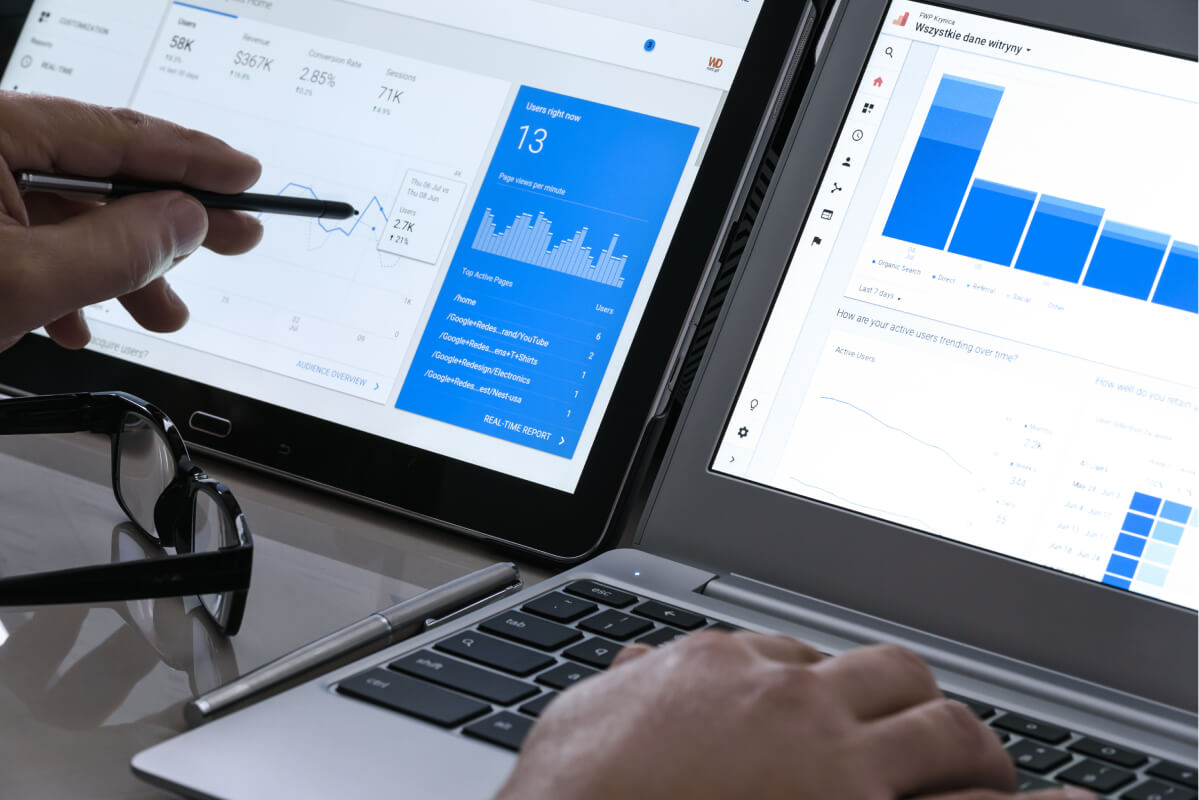What is AIDA and when should it be used?
| By Maciek Popiołek | 0 Comments

Table of contents
Czytasz teraz:
What is AIDA and when should it be used?
Close
Designing the right marketing communication is key to acquiring customers and building a positive company image. This task is greatly simplified by the classic marketing model, AIDA. What is it? What stages does it consist of? How can it be effectively used in communication with customers? We answer these questions!
AIDA – what is it?
AIDA is a classic marketing model that describes all the stages a customer goes through – from the moment they encounter an advertisement to the final decision to purchase. It is an acronym for Attention, Interest, Desire, and Action, which are also the names of the individual stages of the process.
AIDA is one of the most effective ways to plan, create, and analyze marketing communication, proving successful for both businesses offering products for sale and marketing agencies conducting activities on behalf of their clients. The key to effectively using AIDA in daily operations is understanding the significance of each of its elements.
4 Stages of the AIDA Model
As mentioned earlier, AIDA consists of four stages that lead the consumer to purchase. These are:
(You will find the rest of the article below the form)
Contact us and get a free quote
We will analyze your business and prepare an individual price offer for the optimal marketing mix for you. Completely free.
Verseo spółka z ograniczoną odpowiedzialnością with its registered office in Poznań, at the following address ul. Węglowa 1/3, 62-122 Poznań is an administrator of your personal data.
About Verseo
Company’s office is located in Poznań. Company is entered into the register of entrepreneurs, kept by the District Court of Poznań – Nowe Miasto i Wilda in Poznań, 8th Commercial Division of the National Court Division under number 0000596164, NIP (Tax Identification Number): 7773257986. You can contact us by writing a letter on the address indicated above or e-mail:[email protected]
You have right to:
- access to your personal data,
- correct your personal data,
- demand to remove your personal data,
- restrain to process your personal data,
- object of process your personal data,
- transfer your personal data,
- withdraw consent.
If you think we process your personal data not in accordance with the law, you have right to object to supervisory authority – President of Personal Data Protection Office.
We process your personal data to:
- handle your question, based on art. 6 ust. 1 lit. 6 of General Data Protection Regulation
- promote our goods and services including ourselves in connection with your consent, based on art. 6 ust. 1 lit. a of General Data Protection Regulation
- protect or claim in connection with our reasonable interest, based on art. 6 ust. 1 lit. f General Data Protection Regulation
You share your personal data freely. Please remember that without sharing your personal data you will not be able to send us a message, and we will not be able to answer you.
We can share your personal data with trusted recipient:
- providers of tools made for: website analytics, marketing automation,
- hosting operators.
We will process your personal data by the time:
- which is necessary to achieve a specific purpose for which they were collected and after this term by the time which is necessary to protect or possible claim,
- of withdraw your permission .
We don’t process personal data in a way, which would involve making only automated decisions about you. More information about processing of personal data you can find in our privacy policy.
- Attention;
- Interest;
- Desire;
- Action.
What does each of them mean, and what is their significance in the context of effective marketing communication?
Attention
The first stage in the AIDA method is to capture the potential customer’s attention. This has a significant impact on ultimate success, especially today, when consumers are bombarded with thousands of advertising messages at every turn. You need to stand out from the competition and draw attention to your offer by using catchy headlines, slogans, high-quality content, or striking visuals.
Interest
After grabbing attention, the road to sales is still long, but the second stage helps significantly shorten it. It involves generating the customer’s interest in the product or service. At this stage, the consumer begins to seek information about the offer, so your task is to provide content that will aid in the decision-making process. This may include presenting benefits, using logical arguments and emotions, and addressing any potential questions or concerns.
Desire
Once you have sparked the customer’s interest, it’s time for the next stage of the AIDA model. Your advertisements must evoke a strong desire for the customer to own the product or use the service. They must feel that your solution will solve their problem or fulfill a specific need. At this point, it is essential to emphasize the unique features of the product or service, as well as build a positive image and a sense of urgency or exclusivity.
Action
The final stage of the AIDA model is encouraging the customer to take a specific action – preferably a purchase, although signing up for a newsletter or downloading a catalog with the full offer will also be beneficial. The most important thing is that the consumer is now ready for conversion, and your task is to facilitate their final decision-making – CTA (Call to Action) or a promotion may be necessary here.
Where can AIDA be used?
The AIDA model is an incredibly versatile method that works in many businesses and can be used alongside various other marketing tools. These include:
- search engine ads (SEO and PPC);
- content marketing and SEO copywriting;
- remarketing;
- social media ads;
- email marketing.
Which form of promoting products and services you choose depends solely on the goals you want to achieve and the budget you have available.
How to use the AIDA model? Advertising tips
In our descriptions of the individual stages of the AIDA model, we mentioned certain practices that will allow you to use the method for effective sales. However, it is worth expanding on this topic to ensure the marketing strategy is comprehensive and delivers the expected results in a relatively short time. Here are a few tips to help optimize each stage of communication with the customer.
Attention
How to use the AIDA model? Marketing at the initial stage should primarily focus on attracting attention. You can achieve this through striking billboards or banners, perfectly crafted slogans tailored to the target audience, and above all, surprising and intriguing content. This refers not only to written words but also to promotional videos or colorful images that will catch the consumer’s eye and make them stop longer at your offer.
Interest
At the stage of building customer interest, you must present the specific benefits of your offer. Tell them how the solution will make their life easier, highlight the best features of the product or service that will appeal to the customer’s needs, and don’t hesitate to answer any questions. Instructional materials, which demonstrate how the product works, or an optimized website with customer reviews or an FAQ section, could be helpful here.
Desire
What should you do when the customer shows interest? At this stage of the AIDA model, marketing should focus on further emphasizing the unique features of the product that distinguish it from the competition. You can also create a sense of urgency or exclusivity, for example, through a time-limited offer or a limited edition, or invest in ads that show the consumer how the solution will improve their quality of life.
Action
It’s time for actions that will give the customer confidence that your offer is the best and worth using. Here, Calls to Action (CTA) play the biggest role, such as a “Buy Now” button in an online store or specific phrases like “Check It Out,” “See More,” or “Click Here.” To encourage the customer to purchase, you should also provide concrete benefits (e.g., free shipping and a money-back guarantee) and streamline the process (e.g., through a simple and quick order form). Promotional emails with discount codes and direct links to products will also be invaluable support at this stage of AIDA.
How to measure results in the AIDA method?
What is the secret to the success of the AIDA model? Advertising and measuring results will show you whether your marketing messages are performing their task and encouraging customers to take specific actions. But how do you measure them? Here are a few tips for each stage of this method.
Attention
At this stage of AIDA, the most important metrics are website page views and the CTR (Click-Through Rate) for online ads. An essential tool for tracking these parameters is Google Analytics – a completely free solution that provides users access to vast amounts of information.
Interest
To determine whether your marketing efforts are generating customer interest, you should consider the amount of time spent on the website, the number of views of individual product pages, and the bounce rate. Google Analytics will also be helpful here.
Desire
After generating customer interest, it will be necessary to measure other metrics directly linked to actions taken by the customer. The most important here is the conversion rate on the website (e.g., adding products to the cart, submitting an inquiry form, etc.).
Action
At the final stage of the AIDA model, marketing activities are slowly coming to an end. At this point, you can monitor the number of completed transactions and the average order values of customers. The conversion rate will also be invaluable in this case.
AIDA method or another solution?
The AIDA model is not the only method for enabling more effective communication with customers and improving sales. There are also other options available, such as:
- ACCA is somewhat similar to the AIDA model, but its key element is the understanding stage, which makes it possible to convince the customer to make the final purchase;
- DAGMAR, a model in which the most important aspect is defining advertising goals (e.g., understanding the message or brand awareness);
- Hierarchy of Effects is a model focusing on changing customer attitudes towards the brand, their engagement, and loyalty.
Despite the numerous possibilities, the AIDA model remains the most popular choice among businesses and marketers. Therefore, to achieve the desired success, it is advisable to start with AIDA.
AIDA – your path to success
We hope our guide will make it easier for you to plan your future actions and design an effective marketing strategy. You now know what AIDA is. You are also familiar with its stages and how to generate customer interest and desire to own your product or purchase your service. It’s time to take action – if you want to implement it, contact the specialists at Verseo!










Recent Comments